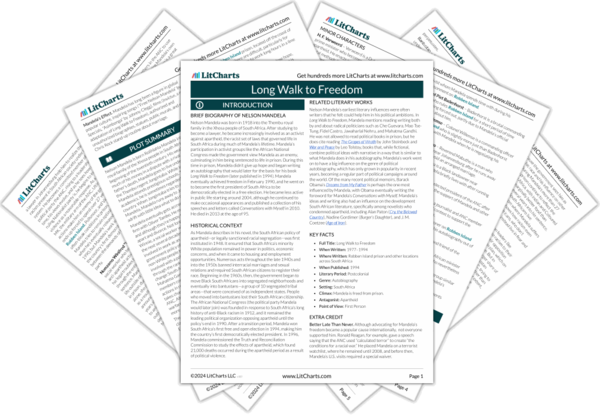In Long Walk to Freedom, Nelson Mandela presents himself as a pragmatist, but this can be difficult when he faces moral and strategic questions about the use of force that have no easy answer. Mandela is a great admirer of Mahatma Gandhi, who famously relied on nonviolent forms of protest like civil disobedience, including general strikes and hunger strikes, while protesting British rule of India. But while Mandela finds some success by employing similar tactics in South Africa, these nonviolent actions don’t do enough to dismantle apartheid, a system of legally-sanctioned racism. As the government’s response to him and his allies becomes more aggressive, Mandela increasingly begins to believe that violence may be necessary to combat apartheid. Mandela weighs options for violent actions that range from sabotaging property to open guerilla warfare, believing that force is required because the government of South Africa is less rational than the British government that Gandhi opposed.
But while the beginning of the book charts Mandela’s evolution from a nonviolent idealist to a more pragmatic and sometimes militant leader, the ending of the autobiography finds Mandela once again considering the value of nonviolence. As his political party, the ANC, attains legitimacy and has a chance to rise to power, Mandela begins to see the spiraling violence in the country as counter-productive, making future unity impossible. Although Mandela never fully rules out violence, he urges his followers to continue the struggle peacefully, namely by voting. This reflects how South Africa has changed—from Mandela’s perspective, the violence that advocated in that past is no longer necessary, in part due to his opposition becoming slightly more reasonable and receptive to new ideas. In his autobiography, Mandela argues that an effective leader is not absolutist about violence versus nonviolence. While he suggests that nonviolence is preferable because it causes less suffering, some opponents and situations can only be addressed with violence.
Nonviolent Protest vs. Violent Protest ThemeTracker

Nonviolent Protest vs. Violent Protest Quotes in Long Walk to Freedom
Even though I thought what I was doing was morally right, I was still uncertain as to whether it was the correct course. Was I sabotaging my academic career over an abstract moral principle that mattered very little? I found it difficult to swallow the idea that I would sacrifice what I regarded as my obligation to the students for my own selfish interests. I had taken a stand, and I did not want to appear to be a fraud in the eyes of my fellow students. At the same time, I did not want to throw away my career at Fort Hare.
In planning the direction and form that MK would take, we considered four types of violent activities: sabotage, guerrilla warfare, terrorism, and open revolution. For a small and fledgling army, open revolution was inconceivable. Terrorism inevitably reflected poorly on those who used it, undermining any public support it might otherwise garner. Guerrilla warfare was a possibility, but since the ANC had been reluctant to embrace violence at all, it made sense to start with the form of violence that inflicted the least harm against individuals: sabotage.
I entered the court that Monday morning wearing a traditional Xhosa leopard-skin kaross instead of a suit and tie. The crowd of supporters rose as one and with raised, clenched fists shouted “Amandla!” and “Ngawethu!” The kaross electrified the spectators, many of whom were friends and family, some of whom had come all the way from the Transkei. Winnie also wore a traditional beaded headdress and an ankle-length Xhosa skirt.
I had chosen traditional dress to emphasize the symbolism that I was a black African walking into a white man’s court. I was literally carrying on my back the history, culture, and heritage of my people.
For me, hunger strikes were altogether too passive. We who were already suffering were threatening our health, even courting death. I have always favored a more active, militant style of protest such as work strikes, go-slow strikes, or refusing to clean up; actions that punished the authorities, not ourselves. They wanted gravel and we produced no gravel. They wanted the prison yard clean and it was untidy. This kind of behavior distressed and exasperated them, whereas I think they secretly enjoyed watching us go hungry.
I responded that the state was responsible for the violence and that it is always the oppressor, not the oppressed, who dictates the form of the struggle. If the oppressor uses violence, the oppressed have no alternative but to respond violently.
I have walked that long road to freedom. I have tried not to falter; I have made missteps along the way. But I have discovered the secret that after climbing a great hill, one only finds that there are many more hills to climb. I have taken a moment here to rest, to steal a view of the glorious vista that surrounds me, to look back on the distance I have come. But I can rest only for a moment, for with freedom come responsibilities, and I dare not linger, for my long walk is not yet ended.











